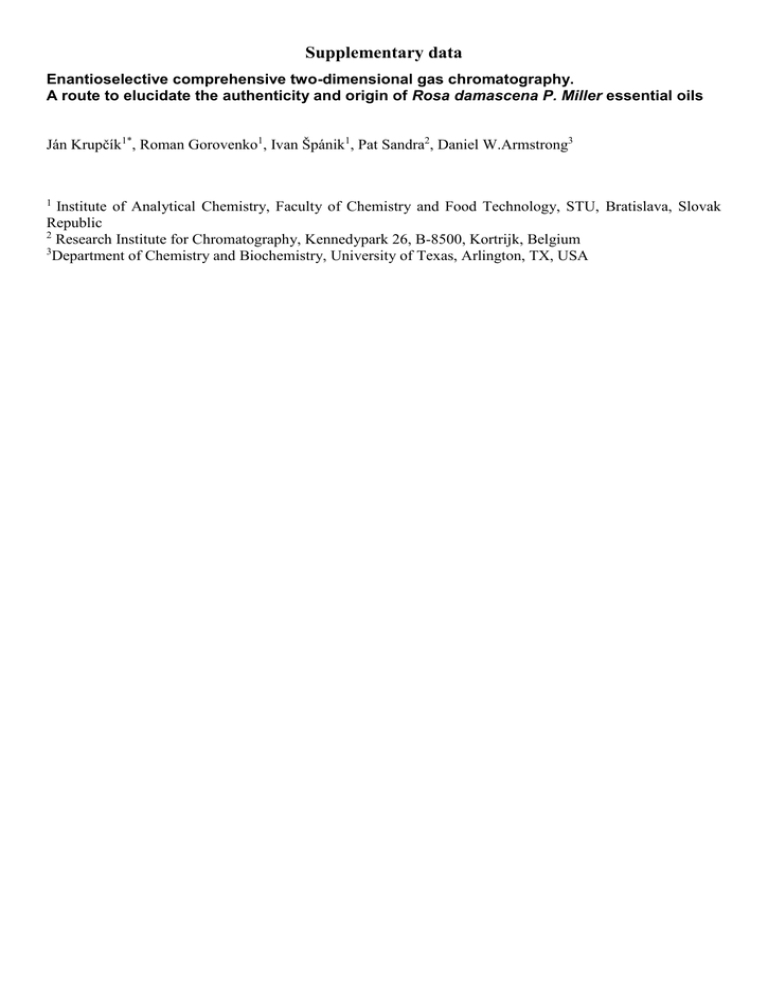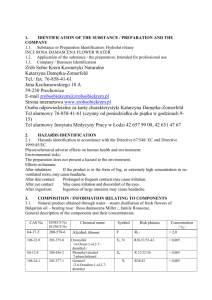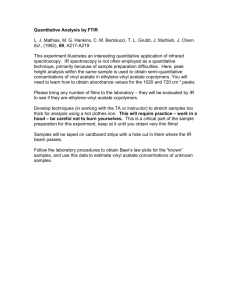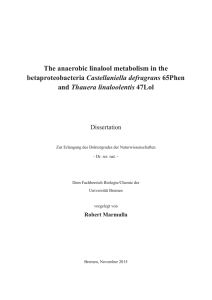jssc4460-sup-0001-tableS1-S4
advertisement

Supplementary data Enantioselective comprehensive two-dimensional gas chromatography. A route to elucidate the authenticity and origin of Rosa damascena P. Miller essential oils Ján Krupčík1*, Roman Gorovenko1, Ivan Špánik1, Pat Sandra2, Daniel W.Armstrong3 1 Institute of Analytical Chemistry, Faculty of Chemistry and Food Technology, STU, Bratislava, Slovak Republic 2 Research Institute for Chromatography, Kennedypark 26, B-8500, Kortrijk, Belgium 3 Department of Chemistry and Biochemistry, University of Texas, Arlington, TX, USA Introduction The most comprehensive study on the composition of the essential oil of Rosa damascena P. Miller essential oil was published by E.Kováts already in 1987 [2]. A “Bulgarian oil 1961“ sample from the harvest of 1960 was analysed by a complex analytical procedure. After classical group separation, the neutral part was further subdivided by “group displacement chromatography” on deactivated silica gel into non-polar, slightly polar and polar parts. Acids and phenols were analysed as methoxy and ethoxy derivatives. The individual groups were first distilled. Pure components were isolated from the distillation fractions by preparative gas chromatography. Fractions isolated on a hydrocarbon-type stationary phase (Apiezon L) were further separated on a polyethylene glycol type sationary phase (Emulphor-O) to yield the pure components. In a second analysis, the oil was separated in a continuous counter-current separator with 680 cells in order to isolate the fraction containing those compounds which are responsible for the “honey note” of the oil. The enriched part (ca. 1% of the oil) was then separated as described above. As a result, 127 compounds were isolated and identified, representing 98.6% of the volatile part. Of these only 40 had been previously reported. The compound mainly responsible for the sweet odor (“honey note”) was shown to be a dehydroisoionone comprising 0.1% of the oil. Because of its organoleptic importance, damascenone was proposed as common name for this substance. Table 2S shows the data obtained by analysis of Bulgarian Rosa damascena P. Miller essential oil by Kováts [2]. For the quantitative analysis the oils resulting from the group separation were chromatographed on a 100 m x 1 mm I.D. stainless-steel capillary caoted with Apiezon L and operated at 90, 130 and 190°C with thermal conductivity detection. Table 1S. Data obtained by gas chromatographic analysis of volatile components in Rosa damascena P. Miller by Kováts [2]. Compound n-Alkanes (16) Undecane Dodecane Tridecane Tetradecane Pentadecane Hexadecane Heptadecane Octadecane Nonadecane Eicosane Heneicosane Docosane Tricosane Tetracosane Pentacosane Heptacosane % 0.001 0.005 0.006 0.006 0.3 0.05 1.63 0.15 9.1 0.7 3.0 0.07 0.5 0.03 0.12 0.02 Monoterpenes (9) Myrcene cis-Ocimene trans-Ocimene -Terpinene -Terpinene Terpinolene (+)-Dipentene (-)--Pinene (-)--Pinene 0.09 0.01 0.04 0.004 0.02 0.02 0.04 0.23 0.04 Sesquiterpenes (8) trans-Sesquimyrcene trans-trans-Sesquicitronellene Humulene (-)-Caryophyllene (?)--Zingiberene (+)-Ylangene (-)-Guajene (+)--Cadinene 0.02 0.01 0.24 4.49 0.008 0.01 0.16 0.1 Aromatic hydrocarbons (2) o,p-Dimethylstyrene p-Cymene 0.02 0.01 Alkenes (5) cis-8-Heptadecene 7-Heptadecene Octadecene cis-9-Nonadecene Eicosene 0.14 0.02 0.05 3.1 0.1 Alkanols (6) Methanol Ethanol 1-Pentanol 1-Hexanol 1-Heptanol 1-Octanol 0.08 1.61 0.02 0.19 0.02 0.01 Compound Hemiterpenes (3) (-)-2-Methyl-butan-1 -ol 3-Methyl-butan-1-ol 3-Methyl-2-buten- 1-ol % 0.05 0.05 0.006 Monoterpene alcohols (7) (-)-Linalool Geraniol Nerol (-)-Citronellol (-)-Terpinen-4-ol (-)--Terpineol (-)-Menthol 2.7 15.7 8.7 32.1 0.34 0.68 0.008 Sesquiterpene alcohols (3) (+)-trans-Nerolidol 2-cis-6-trans-Farnesol trans-trans-Farnesol 0.19 0.15 1.0 Aromatic alcohols (3) Benzyl alcohol 2-Phenylethanol 2,4,6-Trimethylbenzyl alcohol 0.01 1.19 0.10 Miscellaneous (3) trans-3-Hexen-1-ol cis-3-Hexen-1-ol (+)-Methyl heptenol 0.005 0.005 0.002 Alkanals (7) Acetaldehyde Pentanal Hexanal Heptanal Nonanal Decanal Undecanal 0.04 0.02 0.006 0.03 0.03 0.005 0.01 Hemiterpene aldehydes (2) 2-Methylbutanal 3-Methylbutanal 0.004 0.004 Monoterpene aldehydes (3) Neral Geranial (+)-1-p-Menthen-9-al 0.01 0.03 0.008 Aromatic aldehyde (1) Benzaldahyde 0.02 Ketones (9) Acetone 2-Undecanone 2-Tridecanone 2-Pentadecanone Menthone Isomenthone 0.003 0.03 0.02 0.03 0.009 0.004 Table 1S. Continuation. Compound Methylheptenone trans-Geranylacetone* trans-Damascenone* % 0.003 0.1 0.1 Methoxy derivatives (3) Benzyl methyl ether Methyleugenol trans-Anethol 0.01 2.3 0.008 Ethoxy derivatives (1) Acetaldehyde diethyl acetal 0.005 Monoterpene oxides (5) (-)-cis-Rose oxide (-)-trans-Rose oxide (±)-Nerol oxide 1,8-Cineol 2-(3'-Methyl-2'-butenyl)-3-methylfuran 0.38 0.17 0.09 0.003 0.01 Esters (18) Neryl acetate Geranyl acetate (-)-Citronellyl acetate 2-Phenylethyl acetate Menthyl acetate (?)-Citronellyl caprinate 2-Phenylethyl caprinate Ethyl laurate 0.07 0.68 0.53 0.05 0.01 0.005 0.003 0.03 Compound (+)-2-Phenylethyl-2-methylbutyrate Benzyl tiglate 2-Phenylethyl trans-geraniate Methyl trans-geraniate Methyl cis-geraniate Ethyl benzoate Benzyl benzoate 2-Phenylethyl benzoate Dibutyl phthalate 2-Phenylethyl isobutyrate % 0.04 0.2 0.01 0.08 0.001 0.02 0.05 0.07 0.2 0.1 Miscellanous (1) ( ±)- trans-Linalool oxide 0.04 Acids (9) Valeric acid Capronic acid Enanthic acid Caprylic acid Pelargonic acid Capric acid (-)-Citronellic acid cis-Geranic acid trans-Geranic acid 0.001 0.001 0.002 0.004 0.006 0.002 0.01 0.004 0.18 Phenols (2) Eugenol Methyl salicylate 0.55 0.01 Table 2S. ISO 9842:2003. Oil of rose (Rosa×damascena Miller). Compound Ethanol Citronellol Nerol Geraniol -Phenyl ethanol Heptadecane Nonadecane Heneicosane Bulgaria Min. Max 2.0 20.0 34.0 5.0 12.0 15.0 22.0 3.5 1.0 2.5 8.0 15.0 3.0 5.5 Turkey Min. Max 7 34.0 49.0 3.0 11.0 8.0 20.0 3.0 0.8 3.0 6.0 13.0 2.0 4.0 Table 3S. Variability of major components in Turkish Rosa damascena P. Miller essential oil produced during years 1986 to 2001 [28]. Name Citronellol Geraniol Nonadecane Nerol 1-Nonadecene Methyl eugenol Heneicosane Geranyl acetate Linalool 2-Phenylethyl alcohol -Caryophyllene Citronellyl acetate Germacrene D (2E,6E)-Farnesol Min % 30.9 9.3 8.3 5.2 2.6 2.7 2.5 1.0 0.6 1.2 0.7 0.7 0.7 0.6 Max % 43.9 14.1 14.7 7.6 4.9 4.0 4.2 2.2 2.1 1.9 1.6 1.4 1.4 1.4 Table 4S. Elution order of stereoisomers and enantiomers present in Rosa damascena P. Miller essential oil on a heptakis(2,3-O-diethyl-6-O-tert-butyldimethylsilyl)-β-cyclodextrin capillary column. Name Camphor Camphene Carvone Citronellal β-Citronellol Limonene cis and trans Linalool oxide Elution order (R)-(+)-, (S)-(-)(-)-, (+)(-)-, (+)(-)-, (+)- Linalool (R)-(−)-, (S)-(+)- Linalyl acetate Limonene cis, trans Nerolidol (R)-(-)-, (S)-(+)(-)-, (+)two peaks (+/-)-cis-, two peaks (+/-)-trans- α-Pinene β-Pinene (R)-(+)-, (S)-(-) (R)-(+)-, (S)-(-) α-Phellandrene β-Phellandrene Terpinen-4-ol α-Terpineol (-)-, (+)(-)-, (+)(+)-, (-)(-)-, (+)- Sabinene (R)-(+)-, (S)-(-)- (S)-(-)-, (R)-(+)(S)-(-)-, (R)-(+)(+)-trans-, (-)-cis-, (-)trans-, (+)-cis- Ref. C, D C B B B B, E B E B, C C A E E C C C C E (A) GC-Columns-Brochure. Red Analytical. 2009-2013. www.dot-red.com (B) A Guide to the Analysis of Chiral Compounds by GC, Lit. Cat.# 59889, 1997 Restek Corporation. www.restek.com/pdfs/59889.pdf (C) Bonaccorsi I., Sciarrone, D., Cotroneo, A., Mondello, L., Dugo, P., Dugo. G., Rev. Bras. Farmacogn. Braz. J. Pharmacogn. 2011, 21, 841-849. (D) Tateo, F., Bononi, M. , De Dominicis, E., Fumagalli, V., Anal. Commun. 1999, 36, 149-151. (E) Schipilliti, L., Bonaccorsi, I., Cotroneo, A., Dugo, P., Mondello, L., J. Agric. Food Chem. 2013, 61, 1661-1670.






